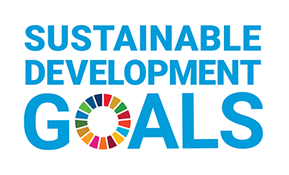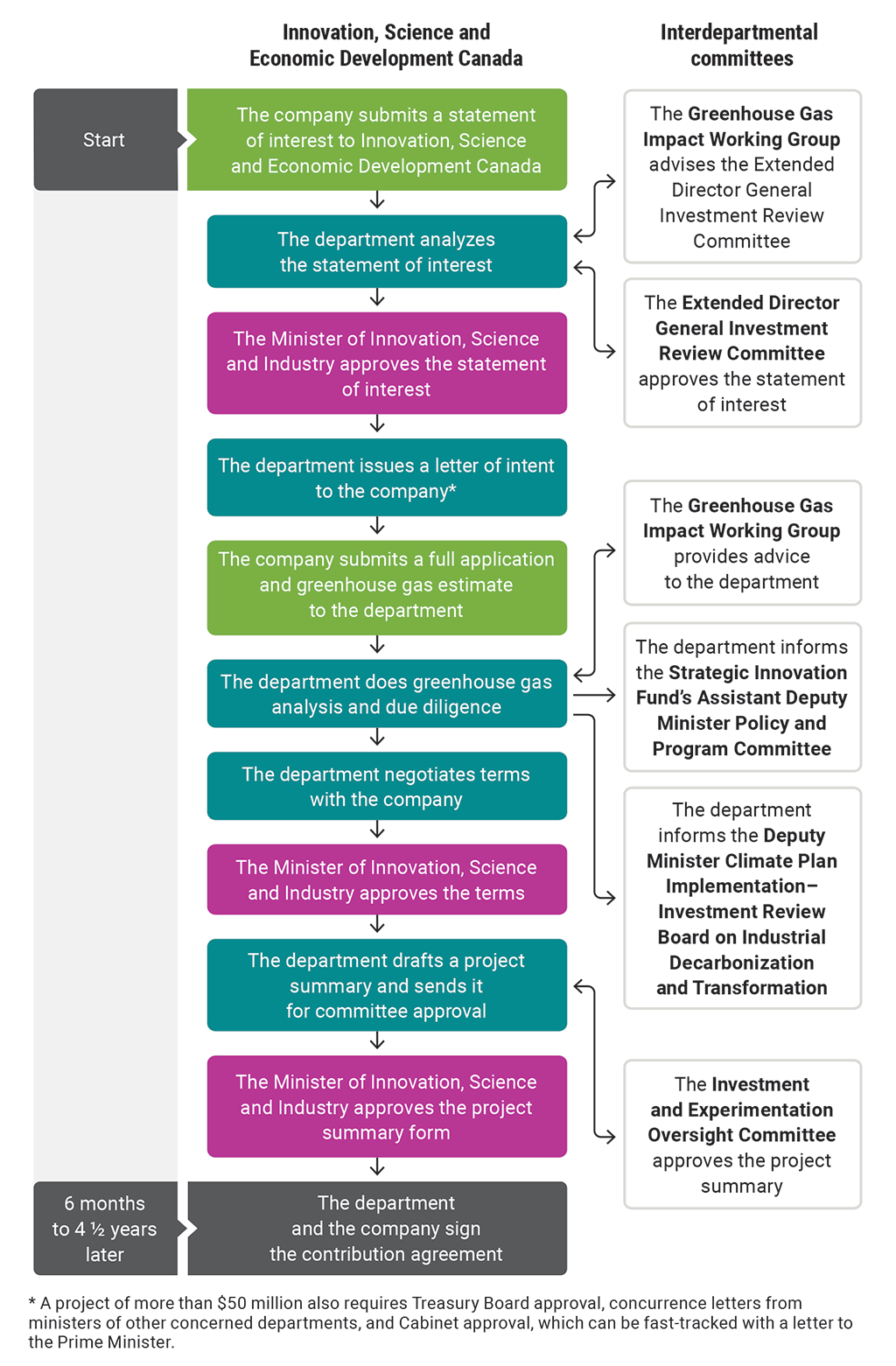2024 Reports 1 to 5 of the Commissioner of the Environment and Sustainable Development to the Parliament of Canada
Report 4—Strategic Innovation Fund’s Net Zero Accelerator Initiative—Innovation, Science and Economic Development Canada
At a Glance
Manufacturing industries are the fourth-largest source of greenhouse gas emissions in Canada but have little incentive to reduce or remove carbon from their operations. The Net Zero Accelerator initiative incentivizes Canadian companies to decarbonize their operations and contribute to meeting Canada’s 2030 and 2050 climate goals.
Overall, Innovation, Science and Economic Development Canada’s management of the $8‑billion Net Zero Accelerator initiative had important shortcomings, such as the fact that the department did not track the Net Zero Accelerator’s overall value for money in reducing greenhouse gas emissions. This is concerning, as the funds are almost all committed.
We calculated the cost to taxpayers of a tonne of greenhouse gas emissions reduced through the initiative to be $143 per tonne for the 5 companies that have a signed commitment to reduce a precise amount of emissions. However, the other 12 of the 17 funded projects did not have a signed commitment as a result of the initiative to reduce a precise amount of emissions, resulting in an overall higher cost to taxpayers at $523 per tonne for all approved projects.
Our audit revealed a larger issue that the government as a whole needs to address. Specifically, we found that the department did not have an industrial decarbonization policy that involved all relevant government entities to guide its efforts. This type of policy would give the department a better picture of which industries are the most in need of funds to reduce emissions and is ensuring the most value for money spent.
For the companies applying for funding, we found the application process very lengthy and complex, requiring an average of 407 hours to complete the application and an average of 20 months to complete the full process before signing the contribution agreement. Given that large emitters already have little incentive to decarbonize their operations, efforts should be made to better attract large emitters and review applications quickly to increase Canada’s opportunities to reduce emissions.
Key facts and findings
- The Net Zero Accelerator was provided with an initial $3 billion to be spent over 5 years. In Budget 2021, the government gave it an additional $5 billion to be spent over 7 years starting in 2021–22.
- Innovation, Science and Economic Development Canada’s calculations of anticipated greenhouse gas reductions for projects funded by the initiative did not always follow international standards, affecting the credibility of the department’s calculations.
- Sometimes due diligence steps within the Strategic Innovation Fund’s Net Zero Accelerator initiative were not followed before funding approval.
- There were $0.4 billion in uncommitted funds left to be allocated of the initial $8 billion in the Strategic Innovation Fund’s Net Zero Accelerator initiative.
- Out of the 55 emitters that emitted at least 1 megatonne of carbon dioxide equivalent in 2021 in Canada, only 15 applied to the Net Zero Accelerator and only 2 of them signed a contribution agreement.
Why we did this audit
- It is important to know whether the considerable money the Government of Canada has put into mitigation programs to reduce the country’s total emissions has been spent economically, efficiently, and effectively.
- The Net Zero Accelerator Fund, at $8 billion, is one of the biggest government initiatives to encourage manufacturing industries to decarbonize.
- If the Net Zero Accelerator does not secure credible emission reduction, the federal government might not fulfill its commitments, which would undermine efforts to address climate change.
Highlights of our recommendations
- To ensure the timely decarbonizing of manufacturing industries, Innovation, Science and Economic Development Canada, in collaboration with appropriate departments and agencies, should develop and implement a strategic horizontal approach detailing steps to reach Canada’s climate goals.
- To make the application process for the Strategic Innovation Fund’s Net Zero Accelerator more efficient and effective, Innovation, Science and Economic Development Canada should analyze how to better encourage large emitters to apply to the initiative, including assessing whether the design of the program is responding to their needs.
Please see the full report to read our complete findings, analysis, recommendations and the audited organizations’ responses.



In September 2015, Canada adopted the United Nations’ 2030 Agenda for Sustainable Development, which includes 17 Sustainable Development Goals. Sustainable Development Goal 13 (Climate Action) calls on governments to integrate climate change measures into national policies, strategies, and planning. The Net Zero Accelerator initiative also contributes to the 2022 to 2026 Federal Sustainable Development Strategy’s Goal 9 (Foster Innovation and Green Infrastructure in Canada) and Goal 13 (Take Action on Climate Change and Its Impacts).
Diversity is related to the United Nations’ Sustainable Development Goal 10 (Reduced Inequalities) and more specifically to target 10.2: “By 2030, empower and promote the social, economic and political inclusion of all, irrespective of age, sex, disability, race, ethnicity, origin, religion or economic or other status.” This international target has been incorporated into the 2022 to 2026 Federal Sustainable Development Strategy as part of Canada’s commitment to take action to reduce inequality.
Visit our Sustainable Development page to learn more about sustainable development and the Office of the Auditor General of CanadaOAG.
Exhibit highlights
The Strategic Innovation Fund’s Net Zero Accelerator is one of many important green initiatives of the federal government
| Category of climate measure | Examples of initiatives and programs | Example of an audit report by the Commissioner of the Environment and Sustainable Development |
|---|---|---|
|
Carbon pricing |
In line with the Update to the Pan‑Canadian Approach to Carbon Pollution Pricing 2023–2030, carbon prices in the Canadian system are $80 per tonne of carbon pollution in 2024, rising to $170 per tonne of carbon pollution in 2030. |
2022 Report 5—Carbon Pricing—Environment and Climate Change Canada |
|
Regulations |
2023 Report 5—Emission Reductions Through Greenhouse Gas Regulations—Environment and Climate Change Canada |
|
|
Financial support, including tax incentives |
|
This report on the Strategic Innovation Fund’s Net Zero Accelerator |
|
Other |
|
2023 Report 7—Departmental Progress in Implementing Sustainable Development Strategies—Zero‑Emission Vehicles |
The approval process for the Strategic Innovation Fund’s Net Zero Accelerator initiative projects was long and complex, involving many parties

Source: Based on information from Innovation, Science and Economic Development Canada
Text version
This flow chart shows the approval process for the Strategic Innovation Fund’s Net Zero Accelerator initiative projects. The process is long and complex, and it involves many parties.
The process starts when the company submits a statement of interest to Innovation, Science and Economic Development Canada.
Next, the department analyzes the statement of interest. During this step, the department interacts with 2 interdepartmental committees. The Greenhouse Gas Impact Working Group advises the Extended Director General Investment Review Committee. The Extended Director General Investment Review Committee approves the statement of interest.
Next, the Minister of Innovation, Science and Industry approves the statement of interest.
Next, the department issues a letter of intent to the company. A project of more than $50 million also requires Treasury Board approval, concurrence letters from ministers of other concerned departments, and Cabinet approval, which can be fast-tracked with a letter to the Prime Minister.
Next, the company submits a full application and greenhouse gas estimate to the department.
Next, the department does greenhouse gas analysis and due diligence. During this step, the department interacts with 3 interdepartmental committees. The Greenhouse Gas Impact Working Group provides advice to the department. The department informs the Strategic Innovation Fund’s Assistant Deputy Minister Policy and Program Committee. The department informs the Deputy Minister Climate Plan Implementation–Investment Review Board on Industrial Decarbonization and Transformation.
Next, the department negotiates terms with the company.
Next, the Minister of Innovation, Science and Industry approves the terms.
Next, the department drafts a project summary and sends it for committee approval. The Investment and Experimentation Oversight Committee approves the project summary.
Next, the Minister of Innovation, Science and Industry approves the project summary form.
Finally, 6 months to 4 and a half years later, the department and the company sign the contribution agreement.
Most emission reductions were expected to come from large emitters, but only 2 had projects with the Net Zero Accelerator as of September 2023
| blank table cell |  Pillar 1—Decarbonization of large emittersNote * |
 Pillar 2—Industrial transformation and Pillar 3—Clean technology and battery ecosystem development |
|---|---|---|
| Initial budgeted funding | $4.0 billion | $4.0 billion |
| Number of contribution agreements signed with a company | 2 | 15 |
| Funding committed in contribution agreements | $0.6 billion | $2.6 billion |
| Emission reductions according to Innovation, Science and Economic Development Canada | 7.2 megatonne of carbon dioxide equivalentMt CO2 eq in 2030 | 4.0 Mt CO2 eq in 2030Note ** |
| Emission reductions that applicants are accountable for in contribution agreements | 5.9 Mt CO2 eq in 2030 | 0.3 Mt CO2 eq in 2030 |
|
Mt CO2: megatonne of carbon dioxide equivalent (the amount of a greenhouse gas that has the same warming potential as a million tonnes (a megatonne) of carbon dioxide over a specified period) |
||
Source: Based on information from Innovation, Science and Economic Development Canada
Infographic

Text version
Strategic Innovation Fund’s Net Zero Accelerator Initiative
Overall, Innovation, Science and Economic Development Canada’s management of the Net Zero Accelerator initiative had important shortcomings.
Overview
- Manufacturing industries produce 13.6% of Canada’s greenhouse gas emissions.
- The Net Zero Accelerator initiative was allocated $8 billion in funding.
- Recipients of the Net Zero Accelerator have committed to reducing 6.2 megatonnes of emissions by 2030.
- There were 17 companies that received funding from the Net Zero Accelerator at the time of our audit.
Innovation, Science and Economic Development Canada had difficulty attracting Canada’s large emitters to apply to the Net Zero Accelerator. Out of 55 large emitters that emitted at least 1 megatonne of carbon dioxide, 15 submitted applications and 2 signed a contribution agreement. $400 million for large emitters was still uncommitted and unallocated.
This is concerning because emission reductions from large emitters, given the size of their operations, are essential to achieve Canada’s climate targets.
The application process for the Net Zero Accelerator was long and complex. The process started when an application form was submitted by the company. It took an average of 407 hours to complete an application form.
The goal of the process was for an agreement to be signed with the department. It took an average of 1 year and 8 months to complete the full process. The shortest time to complete the full process was 6 months, and the longest time to complete the full process was 4 years and 6 months.
The Net Zero Accelerator initiative was not part of any coherent and comprehensive industrial policy on decarbonization.
A coordinated decarbonization policy would give the government a better picture of the industries most in need of funds to reduce emissions and ensure value for money spent on achieving Canada’s 2050 net‑zero goal.
Related information
Tabling date
- 30 April 2024
Related audits
- 2023 Reports of the Commissioner of the Environment and Sustainable Development
Report 5—Emission Reductions Through Greenhouse Gas Regulations—Environment and Climate Change Canada - 2023 Reports of the Commissioner of the Environment and Sustainable Development
Report 6—Canadian Net‑Zero Emissions Accountability Act—2030 Emissions Reduction Plan - 2023 Reports of the Commissioner of the Environment and Sustainable Development
Report 7—Departmental Progress in Implementing Sustainable Development Strategies—Zero‑Emission Vehicles - 2022 Reports of the Commissioner of the Environment and Sustainable Development
Report 1—Just Transition to a Low‑Carbon Economy - 2022 Reports of the Commissioner of the Environment and Sustainable Development
Report 5—Carbon Pricing—Environment and Climate Change Canada
